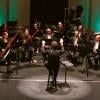
The California Symphony shone at its best in Brahms’s Symphony No. 4 over the weekend. The Fourth is the composer’s most melancholy symphony, but this was not a melancholy performance on Nov. 2 at the Lesher Center for the Arts in Walnut Creek.
Above all else, the interpretation led by Artistic and Music Director Donato Cabrera was firm, though sensitive to emotional nuance. Cabrera kept the drive and flow of the music pressing forward through all the quiet and pensive passages. But he didn’t go overboard in the other direction either. The climaxes, though full of energy, were steadily controlled and precisely executed. There was a strong rhythmic beat when Brahms wanted it, a more lyric flow at other times.
The scherzo — the only such movement in a Brahms symphony, which in many performances pops out in vehemence — was played here with the same reflective tone and relaxed pacing as the other movements. Cabrera kept the music cool. In the concluding passacaglia, the orchestra clearly separated the repetitions of the ostinato theme but made the larger structure evident and smoothly flowing. It’s quite a trick to integrate contrasts like that.
The finest movement, though, was the second. The opening horn themes sounded strong and beautiful. Passages of counterpoint in the strings were even more remarkable, individual lines expressed clearly while blending in exquisite harmony.

The California Symphony opened its season in September with performances of Beethoven’s Ninth that burst with stentorian energy. This Brahms was, appropriately, a more somber work yet equally superlative in interpretation and execution. It also managed to be highly colorful, despite the composer’s taste for subdued shades — which was fortunate because two conspicuously colorful works filled out the program’s first half.
Both were written with the same purpose: to introduce young listeners — or indeed any listeners — to the varied instruments of the orchestra, percussion most emphatically included. First came Benjamin Britten’s The Young Person’s Guide to the Orchestra from 1945, played here without the optional explanatory narration, which the piece doesn’t need.
It’s an entirely straightforward work, beginning with a theme by Henry Purcell — 250 years old when Britten used it — arranged for full orchestra and for each section. The theme is then subjected to a series of variations, one for each major instrument in a character that Britten finds appropriate for it. The piece concludes with a giant fugue, the different instruments entering one by one in the same order as the variations. This is all clear and audible and orchestrated masterfully.
The California Symphony played the work dutifully and with impressive competence in all of the sections. I only wish that the return of the original Purcell theme in the brass at the end of the fugue had risen over the rest of the orchestra.

Britten’s Guide was followed by Philharmonia Fantastique: The Making of the Orchestra by Mason Bates, a former composer-in-residence with the California Symphony. Bates has dubbed his piece “a concerto for orchestra and animated film.” The film, presented on a screen above the stage on Saturday, was created by Lucasfilm artists Gary Rydstrom and Jim Capobianco. It portrays a hand-drawn harlequin-like character, about two inches tall, who jumps around and inside of the instruments onscreen, discovering how they work as live-action musicians play them.
Unlike Britten’s narration, the film here is necessary for the listener. Bates goes through all the major instruments, as Britten does, but he doesn’t write separate variations, and he orchestrates mostly within a given instrumental family, whereas Britten goes for maximum contrast. As a result, it would be difficult in Philharmonia Fantastique to tell which instrument one should be listening to without the film.
Bates writes jagged, shimmering music. He gives each family of instruments a somewhat distinct musical style. After every section has been presented, the families try to play together, but the contrasting styles dissolve into chaos. Then they try again and this time succeed in making a pleasing harmony, ending the work. It’s a pleasant enough piece of music to listen to, though it needs the film to be useful as a guide to the orchestra.




